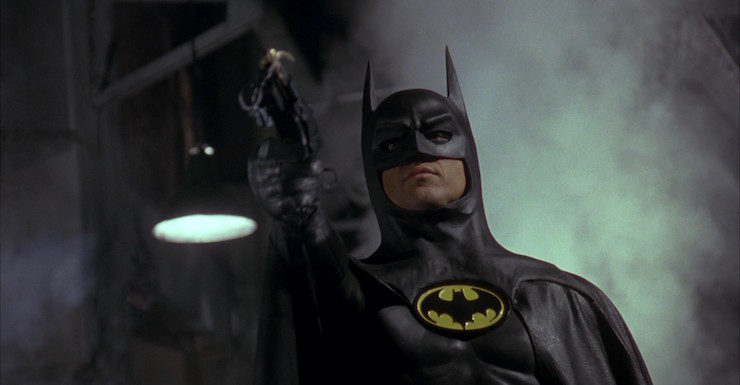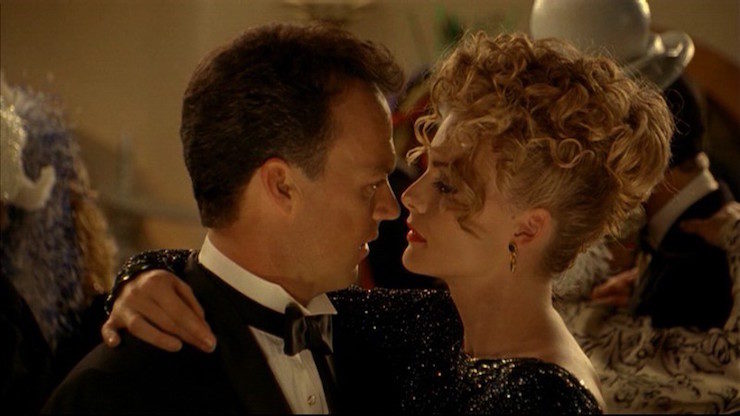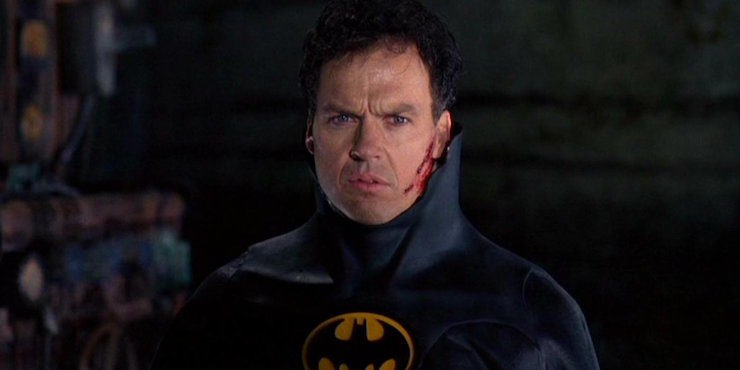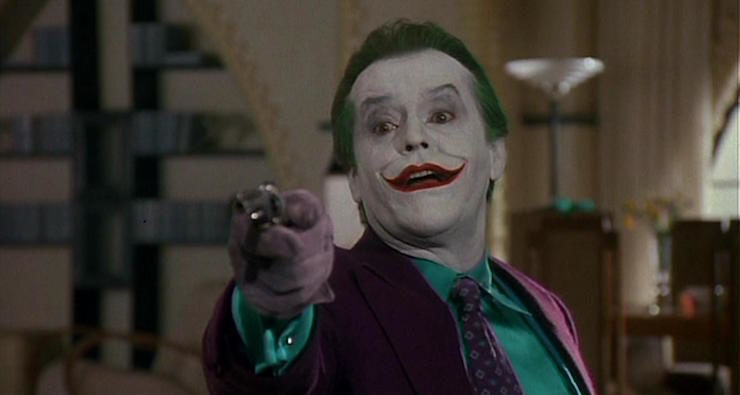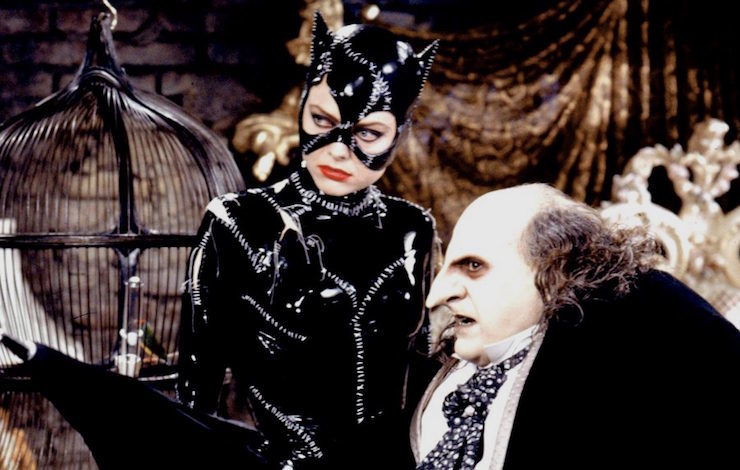In the twenty years between the cancellation of the Adam West Batman TV series and the release of the Michael Keaton Batman movie, there was a significant backlash against the campy, goofy interpretation of Bruce Wayne’s alter ego. In the comics, creators such as Denny O’Neil & Neal Adams and Steve Englehart & Marshall Rogers returned Batman to his noir roots, emphasizing the character’s status as a creature of the night who strikes fear into the hearts of evil-doers.
This culminated in Frank Miller & Klaus Janson’s 1986 four-issue miniseries The Dark Knight Returns, which chronicled an alternate future of an aging Batman coming out of retirement to continue his fight. A year later, Miller would then join David Mazzucchelli to re-tell Batman’s earliest days in Batman: Year One, a story arc in issues #404-407 of Batman’s monthly title. In both cases, the character was taken to even darker extremes, as far from West’s campy Caped Crusader as possible.
In the wake of this renaissance, Tim Burton was tapped to provide his own interpretation of Batman.
DC had been streamlining their multiverse in the 1980s, trying to revitalize interest in their characters by rebooting them. They turned to the creators of their most successful book of the era—Marv Wolfman & George Pérez, the team behind The New Teen Titans—to create Crisis on Infinite Earths. In the wake of Crisis, characters’ origins were reinterpreted or retold, including John Byrne’s Man of Steel, Pérez’s Wonder Woman, and the aforementioned Batman: Year One.
With both Dark Knight and Year One proving to be immensely popular, it was the perfect time for a new Bat-movie. Fan anticipation was mixed given the names attached, though. Burton was best known for Pee-Wee’s Big Adventure and Beetlejuice, a kid’s movie and a comedy, while star Michael Keaton was known more for his comic chops than his dramatic ones. Fear of a return to William Dozier’s sensibilities were rampant.
Obviously, that didn’t happen…
“This town needs an enema.”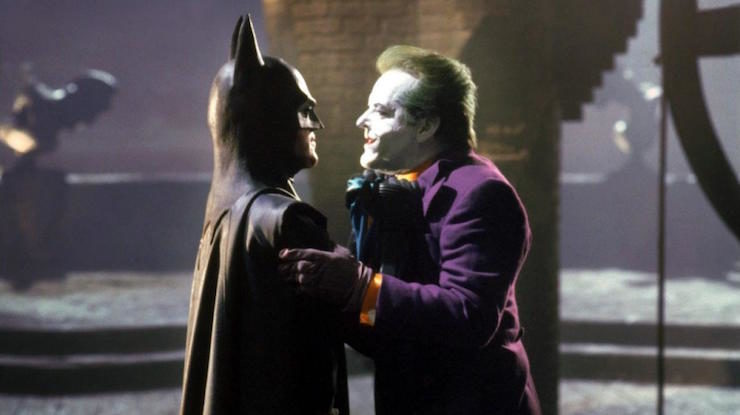
Batman
Written by Sam Hamm and Warren Skaaren
Directed by Tim Burton
Produced by Jon Peters and Peter Guber
Original release date: June 23, 1989
We open with a family leaving the theater and trying to find a cab home. They go down an alley hoping to cut across to Seventh Avenue—instead, they’re mugged. While the muggers count their loot on a nearby rooftop, they’re attacked by Batman—after one of the muggers keeps expressing fears of “the bat” to his skeptical partner. Batman instructs the muggers to tell their friends about him after he beats the crap out of them.
Gotham City is celebrating its 200th birthday, and Mayor Borg assures all and sundry that, despite the high crime rate, the planned celebration will happen, and newly elected District Attorney Harvey Dent will put away Boss Carl Grissom, who is responsible for much of the crime in Gotham. In fact, several members of the Gotham City Police Department are on Grissom’s payroll, as we see Lieutenant Eckhart is on the take, dealing with Grissom’s number-two, Jack Napier.
Napier is sleeping with Grissom’s woman. Napier thinks he’s keeping this secret from Grissom, about which he is 100% wrong. Axis Chemical is a front for Grissom’s operation, and there’s a lot of incriminating evidence there. Napier suggests vandalizing the place and “stealing” the files, making it look like industrial espionage. Grissom likes this idea, and has Napier handle it personally—then calls Eckhart to have him arrest Napier while he’s doing this. (Never sleep with the boss’s girlfriend!)
Reporter Alexander Knox has been reporting on “the bat,” even though most people don’t believe he exists and neither Police Commissioner Gordon nor the mayor nor Eckhart will go on the record as admitting there is such a person. However, freelance photographer Vicky Vale arrives at the newspaper office and says she believes Knox and wants to work with him to get the dirt on this vigilante. She has invitations to a fundraiser Bruce Wayne is holding at his mansion to raise money for the bicentennial celebration, and maybe Knox can get Gordon on the record there.
Neither Gordon, nor Dent, nor Borg will go on the record with Knox, but he and Vale do meet Wayne. Wayne and Vale are particularly smitten with each other, but then Wayne’s butler Alfred pulls Wayne aside, saying that Gordon left in a hurry. Using the surveillance he has all over the mansion, he sees Gordon being taken aside by one of his officers, telling him about the tip on Axis Chemicals, and that Eckhart’s leading the charge.
Eckhart tells the cops he brought along to Axis to shoot to kill, but when Gordon shows up, he makes it clear that he wants Napier and the others taken alive. Batman also shows up, and there’s lots of gunplay and craziness, ending with Napier shooting Eckhart, and then Napier falling into a vat of chemicals.
Napier survives his chemical bath, but his skin is turned white, with his hair turned green, and he now has a permanent smile on his face. Already kinda nuts, Napier is now totally binky-bonkers. He kills Grissom, and takes over his organization, as well as those of the other lesser crime bosses. (When one tries to reject his “unity” plan, Napier uses an electrified joy buzzer to kill him.)
Now calling himself “the Joker,” Napier engages in product tampering to go on a murder spree, combinations of various household products resulting in “smilex” gas, which kills and leaves a smile on the victim’s face. (One victim is a news anchor, who dies right on the air.)
Joker sees a picture of Vale and becomes interested in her. For her part, Vale has spent the night at Wayne Manor, having dinner and staying the night, and charming the heck out of both Wayne and Alfred. But Wayne puts her off, saying he’ll be out of town for a while, even though Alfred later says that they’re not going anywhere. Suspicious, Vale follows Wayne, and sees him put flowers in an alley. Knox does some research, and discovers that Wayne’s parents were mugged and killed right in front of him in that alley.
Vale goes to lunch at the Gotham Museum of Art, thinking she’s been invited by Wayne, but it was, in fact, Joker, who gasses the other patrons and then defaces the art before hitting on Vale. Batman rescues her and takes her to the Batcave in the Batmobile, providing her with the products that are killing people.
Later, Wayne visits Vale, trying to tell her that he’s Batman, but they’re interrupted by Joker and his pals. Joker shoots Wayne, but he manages to save himself with a well-placed metal serving tray (good thing Joker didn’t bother to check the body or notice that there was no blood). Before shooting Wayne, Joker asks if he’s ever danced with the devil in the pale moonlight—the same thing the person who shot his parents asked him right after killing them. Wayne realizes that Napier killed his parents.
Later, Alfred brings Vale to the Batcave from Wayne Manor, thus revealing to Vale that Batman and Wayne are one and the same.
Due to the terrorizing by the Joker, Borg cancels the bicentennial celebration, but Joker cuts into the broadcast announcement of this, saying that there will be a parade, and he’ll throw it and give everyone money, too!
Sure enough, he throws a parade, with balloons filled with Smilex. Batman uses the Batplane to get rid of the balloons and then shoots at Joker, who is standing in the middle of the sidewalk. Somehow, Batman misses with every shot, yet Joker takes the plane down with one shot from a modified pistol. Sure.
The Batplane crashes. Joker grabs Vale, who is photographing the parade, and brings her to the top of Gotham Cathedral. Batman chases him, and they have a moment where each realizes they created the other—then Joker falls over the side and dies.
Batman has arranged for Gordon to have a bat-symbol he can flash into the air to summon Batman when he’s needed.
“Life’s a bitch—now, so am I.”
Batman Returns
Written by Daniel Waters and Sam Hamm
Directed by Tim Burton
Produced by Tim Burton and Denise Di Novi
Original release date: June 19, 1992
Christmas in Gotham City, and the Cobblepot family has a child named Oswald who is hideous. A year later, when the child—who is kept in a cage—eats the family cat alive, his parents take his stroller and drop it into the river. The stroller floats through the sewers, eventually arriving at a spot that is filled with penguins.
Thirty-three years later, there are rumors of a strange penguin creature roaming the sewers of Gotham. The new mayor meets with industrialist Max Schreck, who wants to create a new power plant. The mayor balks, and Schreck threatens him with a recount of his electoral victory; he has enough employees who will sign the petition to call for that recount.
In the midst of a Christmas tree lighting, the so-called Red Triangle Gang—a bunch of former circus folk—attacks. Gordon lights the Bat-signal, and Batman is able to take down most of the gang (including saving Schreck’s mousy assistant Selina Kyle from a guy in a clown suit). However, Schreck is kidnapped by the now-all-grown-up Oswald Cobblepot, who goes by Penguin, and wants to be a person like everyone else. Penguin is also in charge of the Red Triangle Gang. Schreck refuses until Penguin shows him all the blackmail material he’s collected (including the body of Schreck’s former business partner, as well as pieced-together documents that Schreck had shredded). Penguin then stages a “rescue” of the mayor’s infant son during a press conference. Penguin becomes the darling of Gotham after that heroic act, and goes to the Hall of Records to figure out who he is. (While doing so, he also writes down the names of all the first-born sons of Gotham’s elite.)
Kyle goes into the office to prep for a meeting Schreck is having with Wayne to discuss his power plant notion. Kyle was able to get into Schreck’s secure files (she figured out his password, which was the name of his dog; good security, there, Schreck!), and she learns that the power plant will actually take power away from the city and line Schreck’s pockets. Schreck’s response to this security breach is to throw Kyle out a window. She lands in an alley where she is surrounded by cats who bring her back from the dead, er, somehow.
She goes home, trashes her apartment, putting her stuffed animals into the disposal, trashing her dollhouse and sweet furnishing, and shattering the O and the T in her neon sign that says, “HELLO THERE” so now it reads, “HELL HERE.” She also cobbles together a cat costume from an old raincoat.
Schreck’s meeting with Wayne is less fruitful than he’d hoped, and the mayor still isn’t on his side, so he decides to go through with his recount plan, and he props up Penguin as a new candidate. To help solidify his candidacy, Penguin has the Red Triangle Gang go on a rampage. At the same time, Kyle blows up one of Shreck’s department stores. Batman stops the Red Triangle Gang and also fights Kyle on a rooftop, during which both of them are injured.
Now calling herself Catwoman, Kyle goes to visit Penguin, proposing that they team up to stop Batman. Penguin is more interested in getting Catwoman into bed, but he goes along with the notion of turning Batman into a bad guy. He also has gotten his hands on the specs for the Batmobile, er, somehow and plans to use Batman’s car against him. Penguin then publicly challenges the mayor to re-light the Christmas tree.
Wayne and Kyle bump into each other, and Wayne invites Kyle to Wayne Manor to watch the tree re-lighting. They wind up smooching on the couch, each nervous about the other seeing their respective scars from the rooftop fight. Penguin uses a batarang that one of the Red Triangle Gang snagged during the riot and uses it to frame Batman for the kidnapping of the woman who will light the tree. Seeing that, Wayne makes excuses to Kyle and leaves; Kyle also makes excuses and beats a retreat. Batman tries to rescue the woman, but Penguin kills her instead. When Batman gets into the Batmobile to leave, Penguin takes control of it remotely, sending it careening down the street out of control, further sullying Batman’s reputation. Batman records Penguin’s gloating on a CD while he tries to regain control of the car.
Eventually, Batman removes the remote control device and drives back home. As Penguin gives a press conference condemning the mayor’s inability to keep control of the city, Wayne and Alfred broadcast Penguin’s gloating about how he’s playing the city like a harp from hell, which turns public opinion against him.
Penguin retreats to his underground lair and enacts Plan B. While Schreck is throwing a party for Gotham’s rich and decadent, the Red Triangle Gang steals their first-born children. Wayne and Kyle are both attending the party, and they quickly realize each others’ other identities. (“Oh my God—does this mean we have to start fighting?” Kyle asks plaintively.) Penguin crashes the party before things can get too much more awkward. Penguin tries to kidnap Schreck’s son, but Schreck convinces Penguin to take him instead.
Batman is able to rescue the kids and capture the Red Triangle Gang, sending the organ grinder’s monkey back with a note for Penguin. So Penguin sends a mess of penguins to Gotham Plaza armed with missiles. However, Batman and Alfred jam Penguin’s signal and send the penguins back to the underground headquarters. Even as Batman confronts Penguin, Catwoman shows up to confront Schreck. In the end, both Penguin and Schreck are dead, Penguin’s HQ is destroyed, and Catwoman is still roaming around, despite having been shot several times and electrocuting herself with Schreck. (She supposedly has nine lives, because that’s totally how that works.)
“I’m Batman!”
Despite the worries about the people who made Beetlejuice, the director of Pee-Wee’s Playhouse and the star of Mr. Mom, making a Batman movie, 1989 turned out to be the year that everyone went bat-crazy. The film was a huge phenomenon, a massive success that spawned three sequels.
Too bad it’s not a better movie.
There are aspects of the ’89 Batman that are excellent. For starters, the visuals are simply superb. Burton’s Art Deco approach to Gotham City was hugely influential, informing every interpretation of the city that’s been seen on screen since, up to and including the current Gotham TV series. Danny Elfman’s musical score was also fantastic. I’d argue that the best screen interpretation of Batman ever done was the Bruce Timm-produced animated series from the early 1990s, and that series’ visual feel was 100% inspired by Burton’s visuals and Elfman’s music (Elfman wrote the theme song for the series, and his protégé, the great Shirley Walker, provided the show’s brilliant incidental music). Both these first two movies and the animated series seem to take place in a world where it never stopped being the 1930s, with men wearing hats and cameras with big flashes that pop and old-fashioned microphones and such, yet still with modern technology of the late 1980s and early 1990s. It’s a great look for the series, acknowledging the character’s late 1930s roots.
There’s some fine acting here, as the Michaels Keaton and Gough are a great double act as Batman and Alfred, Robert Wuhl is fun as Knox—he’s pretty much our POV character for the first third of the film—and it’s always fun to watch Jack Palance chew the scenery as Grissom.
Unfortunately, the compliments end there on the performance score. Kim Basinger creates absolutely no impression in the wholly pointless role of Vale, Pat Hingle creates even less of one as Gordon, and then we have the guy with top billing.
I won’t say Jack Nicholson is a total disaster, because his Jack Napier is actually very effective. But once he falls into the vat and becomes the Joker, he’s just mugging for the camera. It’s a surface performance of prancing about and acting doofy and just not being very interesting. Some of his line deliveries are great (the script provides him with some superb one-liners that he nails), but the role is ultimately little more than that. There’s no sense of character, of menace. Cesar Romero before him and Heath Ledger and especially the brilliant Mark Hamill after him did far more, much more effectively with the part.
The plot itself is rather incoherent. (The film was a victim of a writers strike, which kept the film from getting the rewrites it so desperately needed.) Joker does things because the script calls for it, but there’s no rhyme or reason, nor is the lack of rhyme or reason played up particularly well. Changing Batman’s origin so that Napier killed the Waynes has possibilities, but aside from one verbal confrontation at the end, absolutely nothing is done with this thematic alteration, thus making it a waste of time. And the romance with Vale is lifeless. The chemistry between Keaton and Basinger is fine, but not enough to justify the grand romance the script in general and Alfred in particular keep insisting it is, and Alfred revealing his secret strikes me as absurd and overreaching. (The sequel actually cops to this, with Wayne giving Alfred a hard time about just letting Vale waltz into the Batcave unexpectedly.)
The sequel is better on every possible level. For starters, both Penguin and Catwoman are characters instead of caricatures. There’s a level of tragedy to both Cobblepot and Kyle, and Danny DeVito and especially Michelle Pfeiffer are able to bring nuance to the roles that Nicholson can’t be bothered with.
Neither can Christopher Walken. His Schreck is the connecting tissue between the otherwise barely related Catwoman and Penguin stories (truly the two barely have anything to do with each other, and the scene where they team up feels horribly grafted on), but he’s so straight-up evil that it’s hard to get worked up over the character’s ups and downs.
Still, Pfeiffer in particular makes the film. Part of me wishes they had just stuck with the one bad guy, as the film is a little too overlong and overcrowded—in a lot of ways, this is two separate movies, the Batman vs. Catwoman movie and the Batman vs. Penguin movie, and both plots might have benefited from more storytelling space. Having said that, at least the two plots follow along sensibly, even if Kyle’s supernatural abilities never get any kind of proper explanation. Cobblepot’s desire for acceptance in the above-ground world, and his resentment of that world, Kyle’s rebirth and renewal, and Batman’s attempts to keep the city safe all work very nicely. The only real misstep is that the attempt to frame him never really goes anywhere, nor does it have any consequences.
Where both films have serious issues is with the fight choreography, which is mostly due to a problem with costuming. Keaton (and Keaton’s stunt double) can’t even turn his head without pivoting his torso in the costume, and it makes the character’s movements choppy and unconvincing. Batman’s physical prowess is rarely in evidence, and when it is, it’s not very impressive. Catwoman’s acrobatics are much better done though, again, there’s no explanation as to how Kyle suddenly is an Olympic-level gymnast…
Despite the general distancing from the 1966 TV series, there are callbacks to the show in both films, from Joker trashing the art gallery (reminiscent of “Pop Goes the Joker” / “Flop Goes the Joker“) to Penguin running for mayor (as he did in “Hizzoner the Penguin” / “Dizzoner the Penguin,” and the character would do so again in Gotham). Paul Reubens also cameos as Penguin’s father in the opening of Returns, and he’ll be back as Penguin’s Dad in Gotham as well.
Neither Burton nor Keaton would return for the third film, and next week we’ll take a look at what Joel Schumacher, Val Kilmer, and George Clooney did with the part.
Keith R.A. DeCandido‘s latest book is Marvel’s Thor: Tales of Asgard, an omnibus of his trilogy of novels starring Thor, Sif, and the Warriors Three, due out in October.










